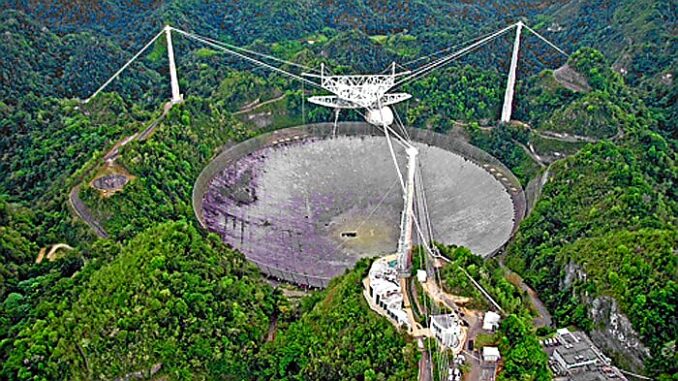
For over 50 years, it was the largest single-aperture radio telescope in the world, not surpassed until July 2016, when China’s Five hundred meter Aperture Spherical Telescope (FAST) came online. Arecibo Observatory in Puerto Rico, also known as the National Astronomy and Ionosphere Center (NAIC), is an icon of the space age which facilitated many important scientific discoveries. Construction started in 1960 and finished in late 1963. The design was ingenious: taking advantage of a natural concave sinkhole in the mountains, a spherical dish reflector was built in the depression with a 1,000 foot (305 meter) diameter. Suspendend 492 feet (150 meters) in the air above the reflector on thick cables attached to concrete towers, the 900-ton radio receiver could be moved around in order to steer, or direct, the focus of the radio telescope. Note that Arecibo did not have a parabolic dish that focused reflected radio energy to a single point where a fixed receiver would be located. Arecibo’s dish was spherical; movement of the suspended receiver above the dish enabled the telescope to be pointed at different objects in the sky without moving the reflecting dish, which was, of course, nestled in its sinkhole, fimly attached to the ground.
Arecibo’s main areas of investigation were atmospheric science, radio astronomy, and radar astronomy. In its early days, the government was interested in detecting ICBMs as the missiles passed through the atmosphere. It was believed they would create a unique radar signature due to atmospheric ionization. Consequently, Arecibo was used to study the upper layers of the atmosphere. Also, the locations of Soviet radar sites were discovered when their signals were detected bouncing off the moon. Additionally, Arecibo has been collecting data since 1999 for the SETI@home project.
As a radio telescope, Arecibo excelled at receiving radio waves from distant galaxies and nebula. Arecibo was also used to study asteroids, moons, and planets using radar. Due to the rotation of the Earth, the telescope could only track objects with radar for 2.6 hours before the object passed outside of Arecibo’s ‘cone’ of sight. Anything beyond the orbit of Saturn was beyond the big telescope’s radar reach, since it took 2.6 hours for a radar signal to reach that far out into the solar system and reflect back again.
There have been many important discoveries made with the Arecibo facilities. Not long after NAIC became operational, Arecibo made it’s first contribution to science on April 7, 1964, with the discovery that planet Mercury’s period of rotation was just 59 days, not the 88 days previously believed. This discovery was made possible with radar.
Evidence of the existence of neutron stars was first obtained in 1968 when astronomers used Arecibo to learn that the Crab Pulsar has a rotational period of just 33 milliseconds.
Binary pulsar PSR B1913+16 was discovered with Arecibo in 1974, earning the researchers the Nobel Prize in Physics.
Astronomers made the first direct image of an asteroid in August 1989, with the radar observation of 4769 Castalia.
The first extrasolar planets were discovered orbiting around pulsar PSR B1257+12, which was imaged by Arecibo in 1990.
Mercury’s distribution of ice in its polar regions was mapped by NAIC in 1994.
These are just a few examples of the many contributions Arecibo has made over the decades. Unfortunately, all good things come to an end.
On November 19, 2020, the National Science Foundation (NSF) announced that Arecibo Observatory will be decommissioned in the coming weeks. The storied radio astronomy dish will be demolished sometime thereafter once a safe plan to do so has been established. The draconian course of action is a result of damage to the dish sustained on August 10, 2020 in the aftermath of Tropical Storm Isaias, and on November 7, 2020. The dish had previously been damaged September 21, 2017, by Hurricane Maria. There have also been a series of earthquakes recently that may have been contributing factors.
Damage to the dish in August resulted when a platform support cable broke and fell, ripping a 100 foot (30 meter) long hole in the reflector surface. Repairs had been planned and a new cable had been ordered when a second support cable broke in November causing much more severe damage than the first.
The structure of the radio observatory shared similarities with suspension bridges. Both employed thick steel cables to suspend massive weight in the air, and both need regular inspection and maintenance. San Francisco’s Golden Gate bridge is a well-known example. The bridge is inspected frequently by engineers, and painted regularly to prevent corrosion. Arecibo Observatory has faced funding difficulties for at least fifteen years, if not longer. I can’t help but wonder if NSF shortchanged the facility, forcing cutbacks in maintenance and engineering inspections.
If there’s a bright side, NSF has stated that parts of the observatory will be saved intact, and can be used for educational purposes. But the giant dish and receiver will be gone.
“Puerto Rico Moves Forward: Arecibo Observatory and Radio Telescope” (3:58):
Question of the Night: What interests you about space/astronomy?
